Celebrating Pride Month at the Cincinnati Art Museum
by Cincinnati Art Museum
6/1/2022
The Cincinnati Art Museum collects art by LGBTQ+ artists working across media. We are proud to celebrate the vibrant diversity represented in our Greater Cincinnati LGBTQ+ community.
Enjoy these works in the museum’s permanent collection by artists who identify as LGBTQ+, or that address themes of LGBTQ+ representation and experience.
Be sure to pick up a self-guided tour through our galleries and while exploring online.
Bernice Abbott (1898–1991)
Berenice Abbott was deeply influenced by the work of French photographer Eugène Atget, whose thousands of images of Paris documented that historic city on the cusp of modernity. In 1935, the Federal Art Project (a Depression-era program supporting the visual arts in the United States) hired Abbott to conduct a photographic survey of New York, recording the old before it was torn down as well as new construction. After four years of work, Abbott selected 302 images depicting the present in a city simultaneously steeped in history and oriented towards the future.
Changing New York is a prime example of serial photography used to give an account that seems deep and comprehensive, even over great distances and the passage of time. Abbott wrote about this picture: “The 999-year lease of the Metropolitan Elevated Railway Company’s lines to the Manhattan Railroad Company will not expire till 2878; and no doubt by then, all the ‘Els’ will be torn down. First drawn by cables, then by dummy steam engines, the lines were electrified in 1902.”

Bernice Abbott (American, 1898–1991), “El” Second & Third Avenue Lines, Bowery and Division Street, Manhattan, April 24, 1936, gelatin silver print, Bequest of Carl M. Jacobs III, 2009.147 © Estate of Bernice Abbott / Howard Greenberg Gallery. View this artwork online.
Nick Cave (b. 1959)
Born in Fulton, Missouri, Nick Cave combines aspects of sculpture, fashion design, dance, and video art in his larger-than-life ‘Soundsuits.’ These full body, form-fitting ‘suits’ are layered and textured with metal, plastic, found objects, and colorfully dyed human hair designed to rattle, swish, and resonate in rhythm with the movements of the wearer, usually Cave himself.
Listen to a museum staff member discuss Cave’s work in the CAM Look episode published on February 22, 2021.
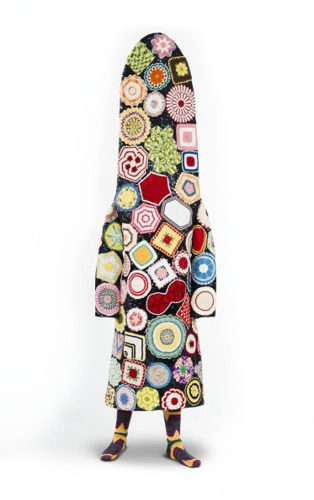
Soundsuit, Nick Cave (American, b. 1959), sculptor, 2009, mixed media, Museum Purchase: Alice F. and Harris K. Weston Endowment for Contemporary Art and Trustee Art Purchase Fund, 2013.19a-d. View this artwork online.
Felix Gonzalez-Torres (1957–1996)
We usually think of a portrait as a visual likeness of the sitter, specifically reflecting their physical appearance. The subject is often surrounded by telling attributes that reference their character, occupation, and social status. But this portrait is unusual. It tells us about an institution rather than an individual, and the artist has chosen to paint the portrait with words and dates.
Commissioned by the Cincinnati Art Museum in 1994, this work conveys the institution’s character through a text-based string of significant events and their dates. The history of the museum, its affinity to the city of Cincinnati, and its connection to the cultural and political events of the nation can be understood through this listing that encircles the lobby near the ceiling. Purposefully organized in non-chronological order, this seemingly random chain of events also references the sporadic nature of the frailty of memory.
Listen to a museum staff member discuss Gonzalez-Torres’ work in this CAM Look episode published on April 23, 2020.
<"max-width: 500px; height: auto; width: 100%; border: none;" src="/media/296485/2010gonzales-torres-5.jpg?width=500&height=375.4152823920266" alt="" data-udi="umb://media/e7c437b138024139b2f607bf9a95aaee" />
Felix Gonzalez-Torres (1957–1996), United States (born in Cuba), Untitled (Portrait of the Cincinnati Art Museum), 1994, paint on wall, Museum Purchase: Gift of the Contemporary Collectors Circle, 1994.218. This artwork is currently on view in the front lobby on the first floor.
Isaac Julien (b. 1960)
Lessons of the Hour is a visionary reflection on the life and legacy of orator, philosopher, and foremost American abolitionist Frederick Douglass, by contemporary artist Isaac Julien. In film and still photographs, the project moves viewers through imagined scenes, historical reenactments, and modern drone footage, connecting current struggles around representation, social justice, and violence to actual events in Douglass’s life—including his 1867 sitting in the downtown Cincinnati portrait studio of African American photographer and abolitionist, James Presley Ball.
Douglass was a nuanced thinker on photography, acutely conscious of its double edge as a tool of oppression and a potential means of emancipated self-representation. As Julien explains, Douglass was “interested in photography because of the role of autonomy it gave him over his own self-representation… He saw photography as a savior,” something that might certify the truth of a person. And yet, as suggested by the aerial images of civil unrest after the 2015 Baltimore police killing of Freddie Grey that Julien included in Lessons of the Hour, photography continues to abet racial injustice as well combat it—Douglass’s quest for just representation is no less relevant today than it was in the 1860s.
Lady of the Lake is a breathtaking, 7ft wide photograph that uses an actor to imagine Anna Murray Douglass, Douglass’s first wife, sitting in J.P. Ball’s Cincinnati studio during their 1867 visit to this city.
Artist quotation from Nadja Sayej, “Isaac Julien on Frederick Douglass: ‘It’s Extraordinary Story,” The Guardian (March 15, 2019). Read more
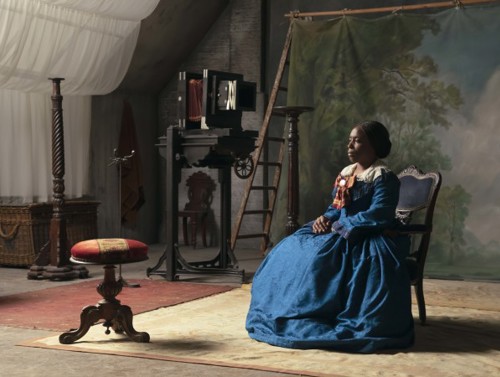
Isaac Julien (British, active United States and United Kingdom, b. 1960), The Lady of the Lake (Lessons of The Hour), 2019, inkjet print mounted on aluminum, Museum Purchase: Carl Jacobs Foundation, 2020.41, © Isaac Julien, Courtesy of the artist and Metro Pictures, New York. View this artwork online.
Ellsworth Kelly (1923–2015)
Ellsworth Kelly was one of America’s greatest living abstract painters. Beginning in the late 1970s, he reduced an already constrained painting style to simple expanses of pure color. His work in recent decades features shaped canvases joined at their edges or superimposed one atop the other. Color and shape are the essential building blocks of form, and Kelly used them to create optical effects of surprising variety.
Bright green and acidic orange are both secondary colors, and here they form a vibrant juxtaposition. The outer curve of the orange canvas implies continuation as if we’re seeing one slice of a large circle. That’s not the only mental projection we make when viewing an abstract canvas like this one. While the satisfying composition stands on its own, images from the world nonetheless surface in our minds. We think of a boat’s sail, children’s building blocks or a fiery sunset partly obscured by a tall building. Kelly, too, found inspiration in the world around him; the power of his work is, in part, its distillation of the world’s visual relationships into forms like this one.
Listen to a museum volunteer discuss Kelly’s work in this CAM Look episode published on March 22, 2021.

Ellsworth Kelly (1923–2015), United States, Green Panel with Orange Curve, 1989, oil on canvas, two joined panels, Gift of PNC Bank, by exchange, 1996.447. View this artwork in Gallery 105 on the first floor.
Germaine Krull (1897–1985)
In 64 astonishing images, Germaine Krull’s Métal evokes the effects of early twentieth-century experimental film montage. As its name suggests, Métal depicts metal architecture and machinery across France and the Netherlands, embracing the forms and energy of modern life over familiar storytelling tools. The portfolio includes images of bridges in Rotterdam and Marseilles, cranes in Amsterdam, and the Citroën factory and Eiffel Tower in Paris. Yet, Krull presents these iconic structures without identifying text, making the metal’s lines, curves, and surfaces her subject.
Read more about Krull in this blog post published on February 10, 2021.
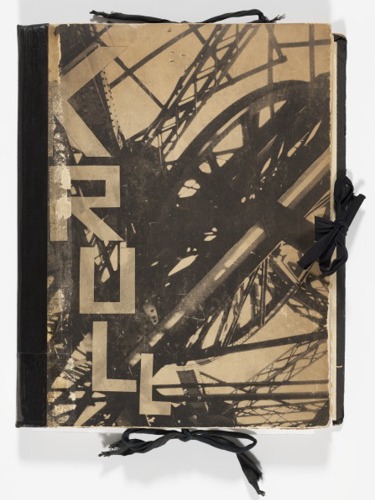
Germaine Krull (French, b. Prussia, 1897–1985), Métal, 1928, collotype plates loose laid in folding case with printed paper cover, black cloth spine and ties, Library Transfer, 2019.298.1-41, © Estate Germaine Krull, Museum Folkwang, Essen. View these artworks online.
Lucas Samaras (b. 1936)
Here, Lucas Samaras explores photographic collage, one way artists use multiple photographs to express ideas a single captured instant could not. The individual Polaroids Samaras took to make this self-portrait were about four by five inches in size. He cut them up and reassembled certain pieces to create a larger picture that appears to be taken from more than one viewpoint – a sly “adjustment” that plays with perception, treats physical reality as malleable and points us towards other photographs. Although Samaras works in many mediums, he is especially well known for fifty years of instant film experimentation conducted within the confines of his Upper West Side apartment. Not only is the kitchen you see here familiar from many other pictures by the artist, but there are also other photographic artworks in this picture. The jarred portraits on the counter are from an earlier series by Samaras, called Heads. Look closely, and you will find Adjustment tells us there is more than one Lucas Samaras – a psychological observation that runs throughout his work.
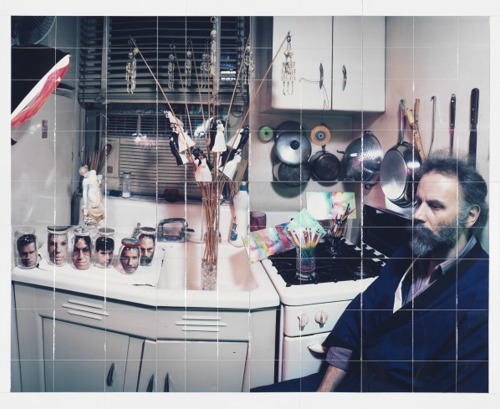
Lucas Samaras (American, b. 1936), Adjustment, January 22, 1986, 1986, dye diffusion print collage (Polaroid Polacolor ER), Bequest of Carl M. Jacobs III, 2009.269, © Lucas Samaras. View this artwork online.
Andy Warhol (1928–1987)
The museum commissioned Andy Warhol to create this portrait commemorating baseball player Pete Rose, who broke Ty Cobb’s longstanding record of 4,191 lifetime hits. Warhol, meaning the painting to resemble a baseball card, based the portrait on a picture taken by Cincinnati photographer Gordon Baer. The Cincinnati Reds’ player-manager became famous for his record number of hits and other contributions to baseball, but Rose’s stature was diminished by his later involvement in a sports-betting scandal.
As one of America’s great Pop artists, Warhol revived the genre of portraiture with his paintings of world-famous personalities. Seeking an “assembly-line” effect, he chose the screen printing technique, a process generally associated with commercial art and mass production. In applying this technique to his portraits, he offered his subjects a promise of immortality—recognition lasting much longer than Warhol’s proverbial fifteen minutes of fame. Pete Rose exemplifies Warhol’s assertion that fame and fortune are fleeting and ambiguous.
Listen to a museum staff member discuss Warhol’s work in this CAM Look episode published on June 24, 2020.
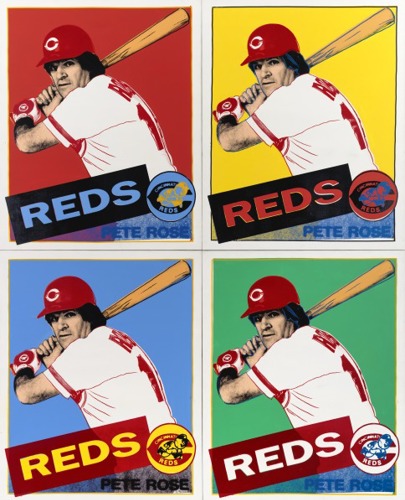
Andy Warhol (American, 1928–1987), Pete Rose, acrylic on canvas with silk screen image, Museum Purchase: Bequest of Mr. and Mrs. Walter J. Wichgar, © 2016 The Andy Warhol Foundation for the Visual Arts, Inc. / Artists Rights Society (ARS), New York, 1985-208a-d. This artwork is currently on view in Gallery 231 on the second floor.
Explore more by LGBTQ+ artists in the museum’s open-access photobook collection.
Browse these physically compact, conceptually expansive works of art at your leisure in the Mary R. Schiff Library. LGBTQ+ artists represented in the museum’s FotoFocus Photobook Collection include Sunil Gupta, Zachary Drucker & Rhys Ernst, Jess Dugan, Allen Frame, Lyle Ashton Harris, Justine Kurland, Zaneli Muholi, Lucas Samaras, Collier Schorr, Hinda Schuman, Jo Spence, Zoe Strauss, Wolfgang Tillmans, and many others. View the collection.






